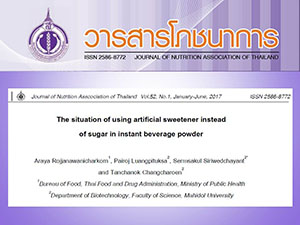The situation of using artificial sweetener instead of sugar in instant beverage powder
Keywords:
Artificial Sweetener, Sugar, Instant Beverage PowderAbstract
Non-Communicable Diseases (NCDs) have a tendency to increase among Thai people every year. One major cause of this issue is over-consumption of sugar, which is commonly found in instant beverage powder that contained a lot of sugar per serving. The purpose of this research is to obtain total sugar and artificial sweetener content in instant beverage powder available in Thailand.A survey was conducted in eight department stores, collecting 243 food and nutrition facts labeled of instant beverage powder. The average total sugar content was 9.92 ± 6.45 grams per serving. There were 69 products (28.39%) using sweeteners instead of sugar, which mostly found in coffee and tea instant beverage powder. A survey of 800 consumers by using online questionnaires found that 21 percent of consumers agreed with the use of artificial sweetener in order to reduce sugar content. Interviewing with 5 entrepreneurs found that most of the food producers had developed products using artificial sweeteners in the instant beverage powder products; however after taste and limited amount of artificial sweeteners added to the products were reported. The tendency of using artificial sweeteners as sugar substitution had continuously increased. Therefore, consumer should be educated to gain insight on how to consume artificial sweeteners safely.
References
2. ชนิดา และ สุนาฏ. อาหาร หวาน มัน เค็ม และความเสี่ยง ต่อการเกิดโรค-หน่วยเคลื่อนที่เพื่อความปลอดภัยด้านอาหาร. (ออนไลน์). สืบค้นวันที่ 14 ธันวาคม 2559. เข้าถึงได้จาก: www.foodsafetymobile.org/category/F2423972.pdf.
3. สำนักอาหาร. น้ำตาลในเครื่องดื่ม. (ออนไลน์). สืบค้นวันที่ 14 ธันวาคม 2559. เข้าถึงได้จาก: https://food.fda.moph.go.th/data/document/2558/CS_sugar.pdf
4. MARKETEER. (2558). ตลาดกาแฟสำเร็จรูป. (ออนไลน์). สืบค้นวันที่ 13 ธันวาคม 2559. เข้าถึงได้จาก: https://marketeer.co.th/archives/38718.
5. ประกาศกระทรวงสาธารณสุข (ฉบับที่ 281) พ.ศ.2547 เรื่อง วัตถุเจือปนอาหาร
6. ประกาศกระทรวงสาธารณสุข (ฉบับที่ 381) พ.ศ. 2559 เรื่อง วัตถุเจือปนอาหาร (ฉบับที่ 4)
7. ประกาศสำนักงานคณะกรรมการอาหารและยา เรื่อง คำชี้แจงประกาศกระทรวงสาธารณสุข (ฉบับที่ 367) พ.ศ. 2557 เรื่อง การแสดงฉลากของอาหารในภาชนะบรรจุ
8. ประกาศกระทรวงสาธารณสุข (ฉบับที่ 383) พ.ศ. 2560 เรื่อง การแสดงฉลากของอาหารในภาชนะบรรจุ (ฉบับที่ 2)
9. วรรณคล เชื้อมงคล. 2551. สารให้ความหวาน: การใช้และความปลอดภัย. Thai Pharmaceutical and Health Science Journal, Vol. 3 No. 1.
10. LOVEFITT. จะลดน้ำตาล เลือกสารให้ความหวาน แบบไหนดีกว่ากัน. (ออนไลน์). สืบค้นวันที่ 30 เมษายน 2560. เข้าถึงได้จาก: https://www.lovefitt.com/healthyfact
11. สถาบันวิจัยโภชนาการ มหาวิทยาลัยมหิดล. 2532. มารู้จักน้ำตาลเทียมกันเถอะ. นิตยสารหมอชาวบ้าน เล่ม 121 ปีที่ 5
12. แผนงานวิจัยนโยบายอาหารและโภชนาการเพื่อการสร้างเสริมสุขภาพ มูลนิธิเพื่อการพัฒนานโยบายสุขภาพระหว่างประเทศ และสำนักอาหาร สำนักงานคณะกรรมการอาหารและยา. 2558.การศึกษาความเข้าใจและการใช้ฉลากโภชนาการหน้าบรรจุภัณฑ์ (Front-of-pack labeling) ของประชากรไทย.(ออนไลน์). สืบค้นวันที่ 24 กรกฎาคม 2560. เข้าถึงได้จาก: https://www.fhppro
gram.org/media/pdfs/reports/

Downloads
Published
How to Cite
Issue
Section
License
Upon acceptance of an article, copyright is belonging to the Nutrition Association of Thailand.


